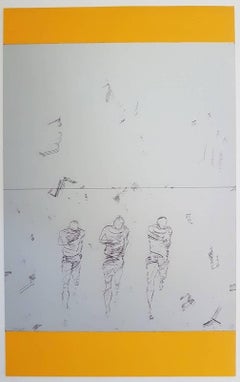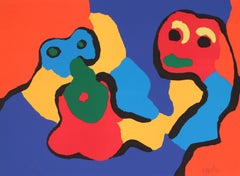John Paul Jones Figurative Prints
John Paul Jones was an American painter and printmaker, described as one of America's foremost printmakers in the 1950s and '60s. Jones was born in Indianola, Iowa in 1924. He enrolled as a pre-engineering major at Simpson College in Indianola in 1943, but his studies were interrupted by World War II. After serving in the military, he began his art training at the University of Iowa in 1946. Jones studied under Lester Longman, James Lechay, Humbert Albrizio and Stuart Edie, but perhaps Mauricio Lasansky's printmaking workshop affected his art the most. 1951 was a pivotal year for Jones. He received his M.F.A. degree in printmaking, was awarded the Louis Comfort Tiffany Foundation scholarship for graphics, given a purchase prize from the Brooklyn Museum National Print Exhibition and joined the faculty of the University of Oklahoma as Instructor in Art. He then taught briefly at the University of Iowa before his appointment in 1953, as Assistant Professor of Art at the University of California at Los Angeles. In 1970, Jones relocated to the Irvine campus of the University of California where he was Professor of Prints and Drawings until 1982. He has had numerous solo exhibitions and an enumeration of his group shows would equal in length a listing of his awards and prizes. He received the Creative Printmaking Award from the Guggenheim Foundation in 1960, which afforded him travel in Europe. His first retrospective was held at the Brooklyn Museum in 1963 and the second followed in 1965, at the Los Angeles County Museum of Art.
1970s Modern John Paul Jones Figurative Prints
Screen
1970s Modern John Paul Jones Figurative Prints
Lithograph, Screen
1970s Modern John Paul Jones Figurative Prints
Screen, Paper
1970s Modern John Paul Jones Figurative Prints
Paper, Screen
Mid-20th Century Modern John Paul Jones Figurative Prints
Screen, Pencil
1970s Modern John Paul Jones Figurative Prints
Lithograph, Screen
Early 2000s American Modern John Paul Jones Figurative Prints
Lithograph, Screen
1990s American Modern John Paul Jones Figurative Prints
Screen
1960s Modern John Paul Jones Figurative Prints
Screen
1970s Modern John Paul Jones Figurative Prints
Lithograph, Screen, Mixed Media, Pencil, Graphite
1940s American Modern John Paul Jones Figurative Prints
Screen
1980s Modern John Paul Jones Figurative Prints
Screen
1970s Modern John Paul Jones Figurative Prints
Screen


